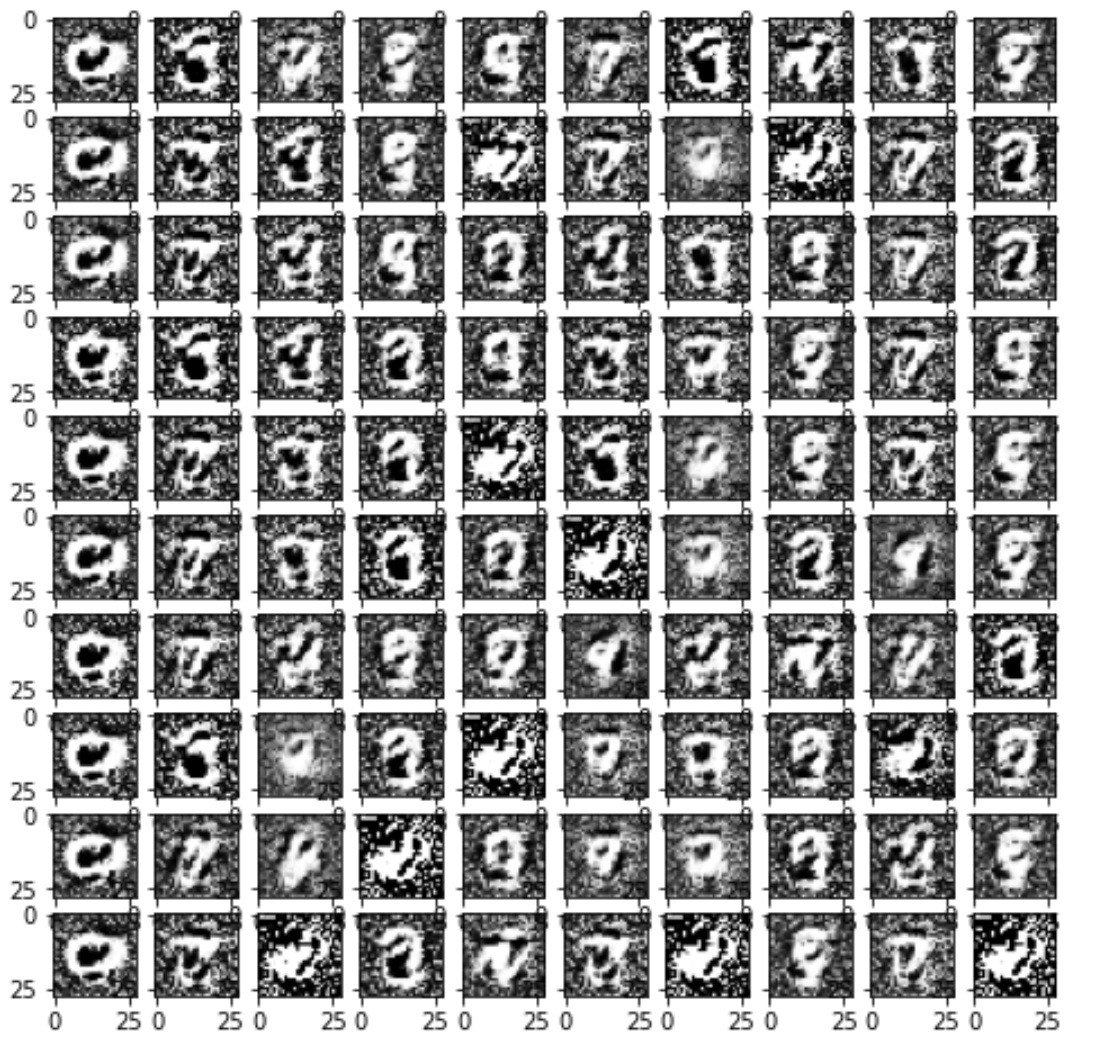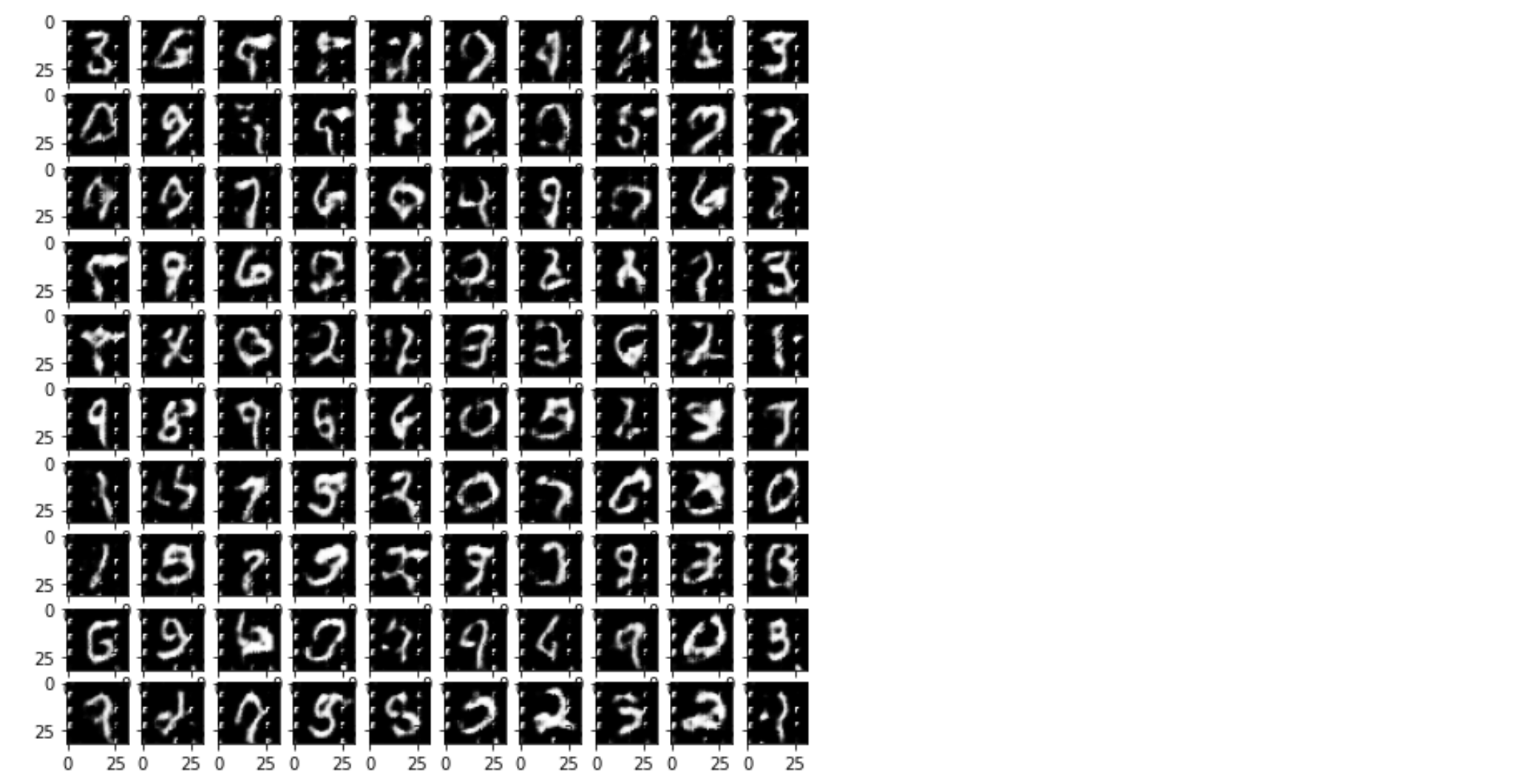CGAN and DCGAN的实例代码——以MINST为例
1、加载数据集
import torch
import torch.nn as nn
import torch.optim as optim
from torchvision import datasets, transforms
import numpy as np
import matplotlib.pyplot as plt
# 基本参数
z_dim = 100
batch_size = 128
learning_rate = 0.000
total_epochs = 30
# 使用GPU训练,可以在菜单 "代码执行工具" -> "更改运行时类型" 里进行设置
device = torch.device("cuda:0" if torch.cuda.is_available() else "cpu")
# 加载MNIST数据集
dataloader = torch.utils.data.DataLoader(
datasets.MNIST('./data', train=True, download=True,
transform=transforms.Compose([transforms.ToTensor(),transforms.Normalize((0.1307,), (0.3081,))])
), batch_size, shuffle=False, drop_last=True)
2、CGAN
class Discriminator(nn.Module):
'''全连接判别器,用于1x28x28的MNIST数据,输出是数据和类别'''
def __init__(self):
super(Discriminator, self).__init__()
self.model = nn.Sequential(
nn.Linear(28*28+10, 512),
nn.LeakyReLU(0.2, inplace=True),
nn.Linear(512, 256),
nn.LeakyReLU(0.2, inplace=True),
nn.Linear(256, 1),
nn.Sigmoid()
)
def forward(self, x, c):
x = x.view(x.size(0), -1)
validity = self.model(torch.cat([x, c], -1))
return validity
class Generator(nn.Module):
'''全连接生成器,用于1x28x28的MNIST数据,输入是噪声和类别'''
def __init__(self, z_dim):
super(Generator, self).__init__()
self.model = nn.Sequential(
nn.Linear(z_dim+10, 128),
nn.LeakyReLU(0.2, inplace=True),
nn.Linear(128, 256),
nn.BatchNorm1d(256, 0.8),
nn.LeakyReLU(0.2, inplace=True),
nn.Linear(256, 512),
nn.BatchNorm1d(512, 0.8),
nn.LeakyReLU(0.2, inplace=True),
nn.Linear(in_features=512, out_features=28*28),
nn.Tanh()
)
def forward(self, z, c):
x = self.model(torch.cat([z, c], dim=1))
x = x.view(-1, 1, 28, 28)
return x
# 初始化构建判别器和生成器
discriminator = Discriminator().to(device)
generator = Generator(z_dim=z_dim).to(device)
# 初始化二值交叉熵损失
bce = torch.nn.BCELoss().to(device)
ones = torch.ones(batch_size).to(device)
zeros = torch.zeros(batch_size).to(device)
# 初始化优化器,使用Adam优化器
g_optimizer = optim.Adam(generator.parameters(), lr=learning_rate)
d_optimizer = optim.Adam(discriminator.parameters(), lr=learning_rate)
# 开始训练,一共训练total_epochs
for epoch in range(total_epochs):
# torch.nn.Module.train() 指的是模型启用 BatchNormalization 和 Dropout
# torch.nn.Module.eval() 指的是模型不启用 BatchNormalization 和 Dropout
# 因此,train()一般在训练时用到, eval() 一般在测试时用到
generator = generator.train()
# 训练一个epoch
for i, data in enumerate(dataloader):
# 加载真实数据
real_images, real_labels = data
real_images = real_images.to(device)
# 把对应的标签转化成 one-hot 类型
tmp = torch.FloatTensor(real_labels.size(0), 10).zero_()
real_labels = tmp.scatter_(dim=1, index=torch.LongTensor(real_labels.view(-1, 1)), value=1)
real_labels = real_labels.to(device)
# 生成数据
# 用正态分布中采样batch_size个随机噪声
z = torch.randn([batch_size, z_dim]).to(device)
# 生成 batch_size 个 ont-hot 标签
c = torch.FloatTensor(batch_size, 10).zero_()
c = c.scatter_(dim=1, index=torch.LongTensor(np.random.choice(10, batch_size).reshape([batch_size, 1])), value=1)
c = c.to(device)
# 生成数据
fake_images = generator(z,c)
# 计算判别器损失,并优化判别器
real_loss = bce(discriminator(real_images, real_labels), ones)
fake_loss = bce(discriminator(fake_images.detach(), c), zeros)
d_loss = real_loss + fake_loss
d_optimizer.zero_grad()
d_loss.backward()
d_optimizer.step()
# 计算生成器损失,并优化生成器
g_loss = bce(discriminator(fake_images, c), ones)
g_optimizer.zero_grad()
g_loss.backward()
g_optimizer.step()
# 输出损失
print("[Epoch %d/%d] [D loss: %f] [G loss: %f]" % (epoch, total_epochs, d_loss.item(), g_loss.item()))
#下面我们用随机噪声生成一组图像,看看CGAN的效果:
#用于生成效果图
# 生成100个随机噪声向量
fixed_z = torch.randn([100, z_dim]).to(device)
# 生成100个one_hot向量,每类10个
fixed_c = torch.FloatTensor(100, 10).zero_()
fixed_c = fixed_c.scatter_(dim=1, index=torch.LongTensor(np.array(np.arange(0, 10).tolist()*10).reshape([100, 1])), value=1)
fixed_c = fixed_c.to(device)
generator = generator.eval()
fixed_fake_images = generator(fixed_z, fixed_c)
plt.figure(figsize=(8, 8))
for j in range(10):
for i in range(10):
img = fixed_fake_images[j*10+i, 0, :, :].detach().cpu().numpy()
img = img.reshape([28, 28])
plt.subplot(10, 10, j*10+i+1)
plt.imshow(img, 'gray')
得到输出:

3、DCGAN
class D_dcgan(nn.Module):
'''滑动卷积判别器'''
def __init__(self):
super(D_dcgan, self).__init__()
self.conv = nn.Sequential(
# 第一个滑动卷积层,不使用BN,LRelu激活函数
nn.Conv2d(in_channels=1, out_channels=16, kernel_size=3, stride=2, padding=1),
nn.LeakyReLU(0.2, inplace=True),
# 第二个滑动卷积层,包含BN,LRelu激活函数
nn.Conv2d(in_channels=16, out_channels=32, kernel_size=3, stride=2, padding=1),
nn.BatchNorm2d(32),
nn.LeakyReLU(0.2, inplace=True),
# 第三个滑动卷积层,包含BN,LRelu激活函数
nn.Conv2d(in_channels=32, out_channels=64, kernel_size=3, stride=2, padding=1),
nn.BatchNorm2d(64),
nn.LeakyReLU(0.2, inplace=True),
# 第四个滑动卷积层,包含BN,LRelu激活函数
nn.Conv2d(in_channels=64, out_channels=128, kernel_size=4, stride=1),
nn.BatchNorm2d(128),
nn.LeakyReLU(0.2, inplace=True)
)
# 全连接层+Sigmoid激活函数
self.linear = nn.Sequential(nn.Linear(in_features=128, out_features=1), nn.Sigmoid())
def forward(self, x):
x = self.conv(x)
x = x.view(x.size(0), -1)
validity = self.linear(x)
return validity
class G_dcgan(nn.Module):
'''反滑动卷积生成器'''
def __init__(self, z_dim):
super(G_dcgan, self).__init__()
self.z_dim = z_dim
# 第一层:把输入线性变换成256x4x4的矩阵,并在这个基础上做反卷机操作
self.linear = nn.Linear(self.z_dim, 4*4*256)
self.model = nn.Sequential(
# 第二层:bn+relu
nn.ConvTranspose2d(in_channels=256, out_channels=128, kernel_size=3, stride=2, padding=0),
nn.BatchNorm2d(128),
nn.ReLU(inplace=True),
# 第三层:bn+relu
nn.ConvTranspose2d(in_channels=128, out_channels=64, kernel_size=3, stride=2, padding=1),
nn.BatchNorm2d(64),
nn.ReLU(inplace=True),
# 第四层:不使用BN,使用tanh激活函数
nn.ConvTranspose2d(in_channels=64, out_channels=1, kernel_size=4, stride=2, padding=2),
nn.Tanh()
)
def forward(self, z):
# 把随机噪声经过线性变换,resize成256x4x4的大小
x = self.linear(z)
x = x.view([x.size(0), 256, 4, 4])
# 生成图片
x = self.model(x)
return x
同理,得到DCGAN生成图:





 浙公网安备 33010602011771号
浙公网安备 33010602011771号